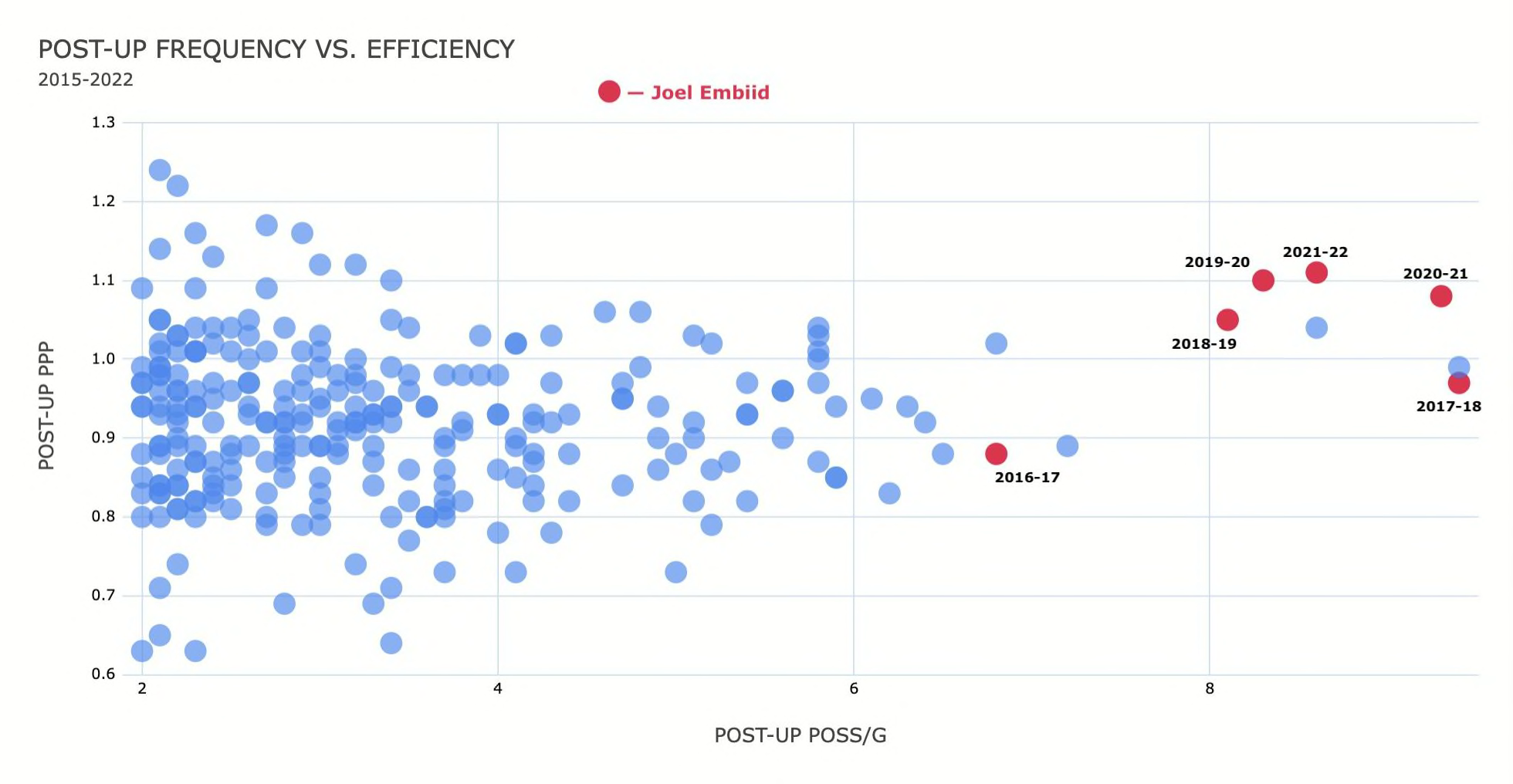The Whiteboard is The Step Back’s daily basketball newsletter, covering the NBA, WNBA and more. Subscribe here to get it delivered to you via email each morning.
The decline of the post-up is well understood, although the degree to which it has led to adaptation rather than extinction doesn’t get enough attention. The post-up has, generally, become a more efficient play type over the past seven seasons but mostly because it is used more selectively and often less as a vehicle for scoring and more as a mechanism for drawing double teams and opening space somewhere else.
But as the league is slowly and collectively zigging, Joel Embiid is making a one-man zag.
In 2015-16, the first year for which play-type data is available on NBA.com, there were 12 players who finished at least 5.0 post-up possessions per game. The nature of this data includes only post-up possessions where the player attempted a shot, was fouled or turned the ball over — it does not include post-ups that led to a pass out and a continuation of the possession.
This year, there is just one player averaging more than 5.0 post-up possessions per game — Joel Embiid. And he’s not just tops in the league, he’s on a complete island, averaging nearly twice as many post-up possessions per game (8.6) as the next closest player, Jonas Valanciunas (4.7). And, somehow, he’s been more efficient than ever, averaging 1.11 points per possession, the best mark of his career.
No one scores in the post as often or as efficiently as Joel Embiid
If you compare Embiid’s post-up frequency and efficiency to every other big man over the past seven seasons, you can see just how much this season (and his recent career in general) stand out.

Those other two dots in the “Embiid Zone” are LaMarcus Aldridge, who is now 36 years old, has already retired once and is, himself, a vestige of another era. The only other players who have finished a season in the past seven years averaging more than 6.0 post-up possessions per game are Al Jefferson (retired), Marc Gasol (retired), Dwight Howard (36 years old), Blake Griffin (32 years old), Brook Lopez (33 years old) and Karl-Anthony Towns.
Towns and Nikola Jokic began their careers a season before Embiid and both are contemporaries who have, at times been potent post-scorers. But both seem to be moving in the opposite direction of Embiid.
Towns is averaging just 3.7 post-up possessions per game this season, scoring at a rate of 0.82 points per 100 possessions (29th percentile). That’s his lowest number for post-up possessions since his rookie season. Meanwhile, he is averaging a career-high in drives per game (7.0) and is attempting considerably more 3-point attempts (5.4) per game than post-up possessions. It seems clear that his evolution is towards a floor game, leveraging his quickness, skill and shooting touch against players of similar size.
Jokic, on the other hand, is still spending plenty of time with his back to the basket, he just isn’t looking to score nearly as often. Player tracking data estimates Jokic at 9.0 post-up touches per game, just a hair behind Embiid. However, he passes on 50.4 percent of these possessions, compared to just 31.8 percent for Embiid. He’s in the midst of a career year and it’s noteworthy that, without two of his best scoring and shooting teammates, he’s fueling it by passing more from the post than ever before.
One has increasingly used the post-up in creative ways to feed into other actions and create openings for his teammates. The other is increasingly using it as a high-efficiency scoring opportunity to batter opponents into submission.
There are a handful of talented young bigs just beginning their NBA careers but it seems likely that all will gravitate more towards the paths of Jokic or Towns than Embiid. Alperen Sengun has averaged 5.6 post-touches per 36 minutes for the Rockets this season, about the same as the season-long numbers but he’s totaled 35 passes to 43 shot attempts and his passing touch and vision seem like a much more viable weapon to be scaled up than his ability to score. Evan Mobley is averaging 3.1 post touches per game but also seems destined to be more valuable as an elbow facilitator, face-up threat and floor-spacer.
That leaves Embiid as the last real dominant high-volume post-scorer in the league, and on the horizon, a throwback to the days of Shaquille O’Neal and Hakeem Olajuwon. For connoisseurs of the post-game, enjoy it now because who knows how long it will last or when we’ll ever see a player like this again.
Other NBA stories:
Miles Bridges has been among the most improved players this year and he’s teetering on the edge of legitimate stardom. It’s a process that was a long time coming and Katie Heindl talked with Bridges about the whole thing.
The Brooklyn Nets are looking to find a new home for Paul Millsap and, if they can stomach trading him to a potential playoff rival, he’d be a perfect fit for the Chicago Bulls.
Dennis Schroder should be incredibly available at the deadline and he actually could solve some problems for the Lakers. And it would be about the funniest possible outcome considering how his time in L.A. ended just a few months ago.
Serge Ibaka’s time with the Clippers is likely coming to an end. It seemed like a perfect fit on paper but circumstances always got in the way.
If you thought Andrew Wiggins was bad, get a load of these other questionable All-Star selections from NBA history.